Birds of Latvia/Aves de Letonia
0.35LVL: The European Roller
0.98LVL: The Eurasian Eagle-owl
The European Roller, Coracias garrulus, is the only member of the roller family of birds to breed in Europe. Its overall range extends into the Middle East and Central Asia and Morocco.
There are two subspecies: the nominate garrulus, which breeds from in north Africa from Morocco east to Tunisia, southwest and south-central Europe and Asia Minor east through northwest Iran to southwest Siberia; and semenowi, which breeds in Iraq and Iran (except northwest) east to Kashmir and north to Turkmenistan, south Kazakhstan and northwest China (west Xinjiang). The European Roller is a long-distance migrant, wintering in southern Africa in two distinct regions, from Senegal east to Cameroon and from Ethiopia west to Congo and south to South Africa.
It is a bird of warm, dry, open country with scattered trees, preferring lowland open countryside with patches of oak Quercus forest, mature pine Pinus woodland with heathery clearings, orchards, mixed farmland, river valleys, and plains with scattered thorny or leafy trees. It winters primarily in dry wooded savanna and bushy plains, where it typically nests in tree holes.
The European Roller is a stocky bird, the size of a Jackdaw at 29–32 cm in length with a 52–58 cm wingspan; it is mainly blue with an orange-brown back. Rollers often perch prominently on trees, posts or overhead wires, like giant shrikes, whilst watching for the large insects, small reptiles, rodents and frogs that they eat.
This species is striking in its strong direct flight, with the brilliant blue contrasting with black flight feathers. Sexes are similar, but the juvenile is a drabber version of the adult.
The display of this bird is a lapwing-like display, with the twists and turns that give this species its English name. It nests in an unlined tree or cliff hole, and lays up to six eggs.
The call is a harsh crow-like sound. It gives a raucous series of calls when nervous.
Some populations migrate to Africa through India. A collision with an aircraft over the Arabian Sea has been recorded.
The European Roller has a large global population, including an estimated 100,000-220,000 individuals in Europe. However, following a moderate decline during 1970-1990, the species has continued to decline especially in Europe, with overall European exceeding 30% in three generations (15 years). In Estonia the 50-100 pairs in 1998 have reduced to no known breeding pairs in 2004; in Latvia and Lithuania populations have decreased from several thousand of pairs in the 1970s to under 30 pairs in 2004. In Russia it has disappeared from the northern part of its range. However, there is no evidence of any declines in Central Asia.
The declines in the European population has resulted in its Red List status being upgraded from Least Concern to Near Threatened in 2005. Threats include persecution on migration in some Mediterranean countries and hundreds, perhaps thousands, are shot for food in Oman every spring. Use of pesticides reduces food availability, and the species is sensitive to changing farming and forestry practices.
The Eurasian Eagle-owl (Bubo bubo) is a species of eagle owl resident in much of Europe and Asia. It is also one of the largest types of owls.
The Eagle Owl is a large and powerful bird, smaller than the Golden Eagle but larger than the Snowy Owl. It is sometimes titled the world's largest owl, but so is the Blakiston's Fish Owl, which is slightly bigger on average.The Eagle Owl has a wingspan of up to 138–200 cm (55–79 in) and measures 58–73 cm (23–29 in) long. Females weigh 1.75-4.2 kg (3.9-9.4 lbs) and males weigh 1.5-3.2 kg (3.3-7 lbs). In comparison, the Barn Owl weighs about 500 grams (1.1 lbs). It mainly feeds on small mammals, but can kill prey up to the size of foxes and young deer (up to 10 kg/22 lb), if taken by surprise. Larger prey (over 3 kg/7 lb) is consumed on the ground which leaves the bird vulnerable (for example to foxes). It is said to be routinely able to swallow a hedgehog whole.
The call of the Eagle Owl is a deep resonant “ooh-hu” with emphasis on the first syllable for the male, and a more high-pitched uh-Hu for the female (in German and Hungarian, the name of this bird is "Uhu" and the Dutch name is “Oehoe”). Each member of an Eagle Owl population can be identified by means of its vocalizations.
The size, ear tufts and orange eyes make this a distinctive species. It has a strong direct flight. The ear tufts of males are more upright than those of females.
The horned owls are a part of the larger grouping of owls known as the typical owls, Strigidae, which contains most species of owl. The other grouping is the barn owls, Tytonidae.
The Eagle Owl is largely nocturnal and is found in mountains and forests with cliffs and rocky areas, usually nesting on cliff ledges. They live for around 20 years although like many other bird species in captivity they can live much longer, perhaps up to 60 years.
In winter
Although Eagle Owls are usually considered to be a bird of the wilderness, they have been observed hunting vermin on open landfills in Northern Europe. This poses a certain risk for the owls as any pollutants the rats they feed on have ingested may be enriched in the owls. Eagle Owls that hunt on landfills have also sometimes been seen flying with waste entangled around their feet.
Eagle Owls have also been observed living in European cities. Since 2005, at least five couples have nested in Helsinki.The number is expected to increase due to the growth of a wild hare population in Helsinki. (Finns do not make a distinction between hares and rabbits. Thus it is sometimes erroneously reported that Eagle owls are feeding on wild rabbits. Hares are extremely common in Helsinki less so rabbits.) In June 2007, an Eagle Owl nicknamed 'Bubi' landed in the crowded Helsinki Olympic Stadium during the European Football Championship qualification match between Finland and Belgium. The match was interrupted for six minutes. After tiring of the match, following Jonathan Johansson's opening goal for Finland, the bird left the stadium. Finland's national football team have had the nickname Huuhkajat (Finnish for Eurasian Eagle-owls) ever since. The owl was named "Helsinki Citizen of the Year" in December 2007.. The best place to see Eagle owl for the tourist in Helsinki is in the Kamppi area. Try the top of the Forum shopping centre between the main Railway station and Kamppi Metro













.jpg)























 taiwan
taiwan  cover or postcard
cover or postcard  FDC
FDC 






























































































No comments:
Post a Comment